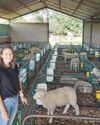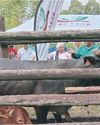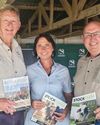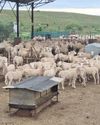Intentar ORO - Gratis
The Mukota: Saving the breed from extinction
Stockfarm
|January 2021
The Mukota is an indigenous, domestic pig found primarily in Zimbabwe with smaller populations found in Mozambique and Zambia.

No official national survey has been conducted in Zimbabwe to determine its population size, but academics estimate that there are around 70 000 pigs, the bulk of which are owned by communal farmers, each keeping a small number for household consumption.
The breed is disease- and parasite tolerant, performs well on open veld and can thus be produced at minimal cost. It has served as a lean meat option in Zimbabwe for centuries but has never been produced commercially. Its population has been declining rapidly in recent years, sparking fears that it might be on the road to extinction.
Plans to expand breed numbers
Chris Grant, a Zimbabwean farmer who owns the Mzilikazi Kalahari Red Stud, is pioneering a drive to arrest the iconic pig’s decline. He started breeding the Mukota commercially in February 2016 – an effort he hopes will encourage other farmers to follow suit.
He and a partner started off with twelve animals, which grew into a 300-strong herd in only three years. They later dissolved the partnership, dividing the pigs equally among themselves.
Grant keeps his Mukotas on a 40ha farm in Nyamandhlovu in the province of Matabeleland North, roughly 40km northwest of Bulawayo. “The Mukota is a good breed. It can take care of itself and we only provide a small portion of supplements. It is also very strong and has exceptional disease and parasite tolerance. I have not given a single antibiotic in four years,” says Grant.
He sells some of the animals to butchers and others to people wanting to start breeding their own pigs.
A very hardy breed
Esta historia es de la edición January 2021 de Stockfarm.
Suscríbete a Magzter GOLD para acceder a miles de historias premium seleccionadas y a más de 9000 revistas y periódicos.
¿Ya eres suscriptor? Iniciar sesión
MÁS HISTORIAS DE Stockfarm
Stockfarm
Trust and muffins lead the way
In any business, communicating in silos is the main cause of issues among managers. With only three of us managing things, myself on sheep, Gert on vehicles and Mbali on payments, breaking through our silos is easy. Twice a week we hold short morning meetings to report progress and problems towards our goal of turning grass into sheep for profit.
2 mins
December 2025
Stockfarm
Santa's new team
Last December, we warned Santa Claus of the perils of visiting South Africa with his team of reindeer. We cautioned him about the biological hazards his reindeer might bring into the country, and the import tariff issues he might encounter when trying to bring in all those gifts. We also elaborated on the heat and other environmental challenges his team might face. But we also told him about our friendly farmers and the braais he might be invited to, complete with a beverage of his choice.
3 mins
December 2025

Stockfarm
The effect of iucerne hay quaiiiy on feedlot lambs
Lucerne hay is one of the most widely used roughage sources for ruminant diets, largely due to its reputation for providing high-quality nutrition. Important considerations for producers who use lucerne hay in their feed programme include assessing the true value of lucerne hay, determining the most suitable grade for specific feeding purposes, considering its cost, and balancing these factors against optimal feedlot performance.
3 mins
December 2025

Stockfarm
Imfuyo-yami Ingumcebo Wami: Livestock as a legacy of wealth and wisdom
In the heart of KwaZulu-Natal, under the warm sun and the watchful gaze of the rolling hills, the Hlawini Community Hall in Umfolozi Local Municipality came alive with the spirit of unity, learning, and tradition. The occasion? The Umfolozi Livestock Farmers' Information Day, held under the banner of the Agricultural Research Council's (ARC) Kaonafatso ya Dikgomo (KyD) project, a national an initiative aimed at empowering communal livestock farmers through knowledge, technology, and sustainable practices.
3 mins
December 2025

Stockfarm
Celebrating the 2025 Komga Agricultural Show
This year's Komga Agricultural Show, energised by the arrival of summer and filled with festive stalls, was a hive of activity. The grounds came alive with live music, a poultry exhibition, the familiar sounds of cattle and sheep in the pens, displays of horsemanship, and top-quality technology and implements on show.
2 mins
December 2025
Stockfarm
DSA reaches new milestone on the road to excellence
The Dairy Standard Agency (DSA) has enjoyed an exceptional 2025 so far, marking two major achievements that underscore its ongoing pursuit of excellence.
3 mins
December 2025
Stockfarm
Samic: Protector of red meat quality
If you thought the South African Meat Industry Company (Samic) is just about carcass competitions, think again. Fact is, the company plays a pivotal role in South Africa's meat supply chain, upholding rigorous standards of quality, safety, and transparency from the farm gate to the plate.
3 mins
December 2025

Stockfarm
Wireworm management in small stock
Years of indiscriminate dosing have eliminated weaker wireworms, allowing resistant populations to dominate and spread through flocks. Wireworms typically hatch following good rains and warm nights. When larvae move up the green grass, they are ingested by grazing sheep. About 20 days later, the worms begin sucking blood, leading to anaemia and, in severe cases, death.
2 mins
December 2025

Stockfarm
Back to basics at the 2025 LRF Stockman School
The 17th Annual LRF Stockman School, hosted by the Livestock Registering Federation (LRF), kicked off with great enthusiasm at the Aldam Holiday Resort and Conference Centre in the Free State. Held over three days, the event brought together leading experts from a range of fields who met everyone's expectations by addressing relevant and timely topics head-on.
7 mins
December 2025

Stockfarm
Vertical gains in the lambing pen: It's not just about the numbers
In a world where rising input costs and increasing consumer demands play a decisive role, it has become more important than ever for red meat producers to raise lambs that not only benefit the producer but also add value throughout the entire supply chain.
4 mins
December 2025
Translate
Change font size

